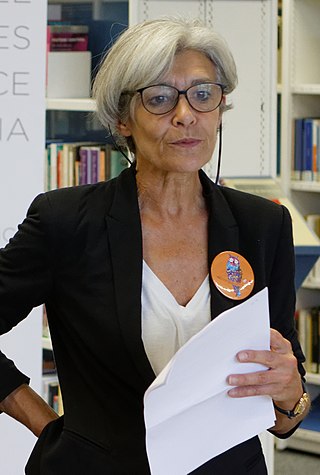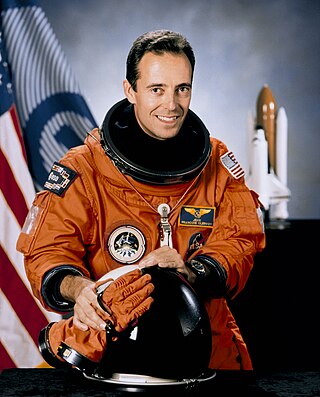
Soyuz TM-27 was a Russian spaceflight that ferried cosmonauts and supplies to the Russian space station Mir. It was the 33rd expedition to Mir. It was launched by a Soyuz-U rocket from Baikonur Cosmodrome on January 29, 1998. The main mission was to exchange one crew member, carry out French mission PEGASE, and conduct routine science experiments.

Claudie (André-Deshays) Haigneré is a French doctor, politician and former astronaut, the first woman astronaut of the French space agency CNES and the European space agency ESA which went to space.

Jean-François André Clervoy is a French engineer and a CNES and ESA astronaut. He is a veteran of three NASA Space Shuttle missions.

Jean-Pierre Haigneré is a French Air Force officer and a former CNES spationaut.

Valery Grigoryevich Korzun is a former Russian cosmonaut. He has been in space twice totalling 381 days. He has also conducted four career spacewalks.

Michel Ange-Charles Tognini is a French test pilot, engineer, brigadier general in the French Air Force, and a former CNES and ESA astronaut who served from 1 January 2005 to 1 November 2011 as head of the European Astronaut Centre of the European Space Agency. A veteran of two space flights, Tognini has logged a total of 19 days in space. Tognini has 4000 flight hours on 80 types of aircraft. He is fluent in English and Russian.

Soyuz TM-33 was a crewed Russian spaceflight which launched on October 21, 2001, on the Soyuz-U launch vehicle. It carried Russian cosmonauts Viktor Afanasyev, Konstantin Kozeyev, and French cosmonaut Claudie Haigneré to the International Space Station.

Soyuz TM-23 was a Soyuz spaceflight which launched on February 21, 1996, to Mir. The spacecraft launched from Baikonur Cosmodrome, and after two days of flight, Yuri Onufrienko and Yury Usachov docked with Mir and became the 21st resident crew of the Station. On September 2, 1996, after 191 days docked with Mir, the ship undocked with the launch crew and Claudie André-Deshays onboard, before eventually landing 107 km (66 mi) south west of Akmola, Kazakhstan.

Thomas Arthur Reiter is a retired European astronaut and is a Brigadier General in the German Air Force currently working as ESA Interagency Coordinator and Advisor to the Director General at the European Space Agency (ESA). He was one of the top 25 astronauts in terms of total time in space. With his wife and two sons he lives near Oldenburg in Lower Saxony.

The German astronaut team was established in 1987. Before the establishment of the team, then-West German astronauts were selected for single missions, or as part of the European Space Agency's crewed spaceflight activities. East Germany had its first cosmonaut, Sigmund Jähn; Jähn was both West and East Germany's first citizen in space when he departed from Baikonur in the Soviet Union in August and returned to Earth in September 1978. West and East Germany reunified in 1990 and the astronaut team became representative of a single German nation.
The European Astronaut Corps is a unit of the European Space Agency (ESA) that selects, trains, and provides astronauts as crew members on U.S. and Russian space missions. The corps has 13 active members, able to serve on the International Space Station (ISS). The European Astronaut Corps is based at the European Astronaut Centre in Cologne, Germany. They can be assigned to various projects both in Europe or elsewhere in the world, at NASA Johnson Space Center or Star City.

Michael Reed "Mike" Barratt is an American physician and a NASA astronaut. Specializing in aerospace medicine, he served as a flight surgeon for NASA before his selection as an astronaut and has played a role in developing NASA's space medicine programs for both the Shuttle–Mir program and International Space Station. His first spaceflight was a long-duration mission to the International Space Station, as a flight engineer on the Expedition 19 and 20 crew. In March 2011, Barratt completed his second spaceflight as a crew member of STS-133. Barratt made a second long-duration mission to the International Space Station, as a flight engineer on the Expedition 70, 71 and 72 crew and also served as the pilot on the SpaceX Crew-8 mission.

Thomas Gautier Pesquet is a French aerospace engineer, pilot, European Space Agency astronaut, actor, musician, and writer. Pesquet was selected by ESA as a candidate in May 2009, and he successfully completed his basic training in November 2010. From November 2016 to June 2017, Pesquet was part of Expedition 50 and Expedition 51 as a flight engineer. Pesquet returned to space in April 2021 on board the SpaceX Crew Dragon for a second six-month stay on the ISS.

Jean-Loup Jacques Marie Chrétien is a French retired Général de Brigade in the Armée de l'Air, and a former CNES spationaut. He flew on two Franco-Soviet space missions and a NASA Space Shuttle mission. Chrétien was the first Frenchman and the first western European in space.






















